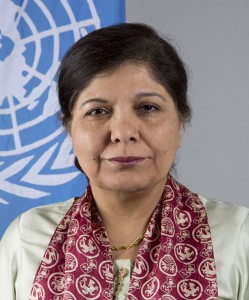Widening the STI Net for Implementation of the Sustainable Development Agenda
Bangkok, May 11 (IPS) - Investment in science, technology and innovation (STI) needs to be the backbone of productivity-led economic recovery and sustainable development. Despite significant increases in productivity over the past few decades, economic growth in developing economies of Asia and the Pacific has been primarily driven by factor accumulation. However, the average rate of productivity growth slowed between 2000-2007 and 2008-2014 by 65%, which has contributed to the economic slowdown and can undermine efforts to effectively pursue the 2030 Agenda for Sustainable Development. We must revive growth in productivity, one of the keys to which is a highly-skilled labor force.
However, the report also points out that these impressive gains have been confined to a relatively small number of economies. For example, 95% of the region's researchers are located in just five countries. To meet the ambitions of the 2030 Agenda, the Asia-Pacific region will need to harness all of its potential resources, with a particular focus on widening the STI net.
Business as usual is not an option for the region if STI is to be used as an effective means of implementing the Sustainable Development Goals. The scale and depth of the Goals require a radically different and disruptive approach—the essence of innovation—along with significant scientific breakthroughs and technological advancements. The limited reach of STI achievements in the region so far will not, however, be sufficient to ensure that the Goals are met in the next 15 years. There are four elements that must be urgently addressed:
First, we must develop a common and effective conceptual framework to enable STI to be more economically and socially inclusive, while promoting climate resilience and the reduction of carbon emissions. Effective institutions and digital infrastructure, appropriate legal and regulatory frameworks, commitment to and incentives for investment, and a workforce for the future are all critical components of such a framework.
Second, to implement the Goals, governments will need to develop integrated and visionary STI policies, while incentivizing businesses and investors to support the three dimensions of sustainable development—economic, social and environmental. This will require explicit consideration of all three outcomes in any reporting standards.
Third, to be supportive of sustainable development, STI policies and strategies need to be inclusive, open and collaborative. Being inclusive in how we innovate, engaging vulnerable communities in the process of innovation and developing innovations that are accessible and affordable to people living in poverty, will be critical to ensure that no one is left behind.
Finally, there is ample scope for regional STI collaboration in Asia and the Pacific. The challenge is to develop concrete and sustainable innovation and technology sharing opportunities to help bridge the gaps that remain, to enable countries at all levels of development to take advantage of available technologies and to develop a robust regional culture of innovation.
ESCAP's Harnessing STI report is a call to action on regional STI collaboration, to provide a resilient and productivity-driven foundation for a successful pursuit of the Goals. Our region has a wide range of opportunities for private sector innovation, grass-roots innovation, international technology transfer, frugal innovation, foreign direct investment, impact investment, enabling research excellence and supporting mass entrepreneurship, to name but a few. This is why ESCAP is proposing the establishment of a knowledge-sharing platform and the development of specific links between the various global and national efforts.
Regional collaboration will be crucial to share knowledge on what works, and to keep pace with the challenges and opportunities that this fast-moving and ever-changing agenda presents. The benefits of a wider STI net are inextricably intertwined with successful achievement of the 2030 Agenda.
(End)
© Inter Press Service (2016) — All Rights ReservedOriginal source: Inter Press Service
 Global Issues
Global Issues